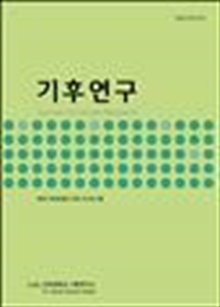간행물
기후연구 KCI 등재 Journal of Climate Research

- 발행기관 건국대학교 기후연구소
- 자료유형 학술지
- 간기 계간
- ISSN 1975-6151 (Print)2288-8772 (Online)
- 수록기간 2006 ~ 2021
- 주제분류 사회과학 > 지리학 사회과학 분류의 다른 간행물
- 십진분류KDC 453DDC 551
권호리스트/논문검색
제11권 제4호 (2016년 12월) 5건
1.
2016.12
서비스 종료(열람 제한)
This study was aimed to analyse spatial patterns of the monthly amounts of damage by heavy snowfall in Korea using damage data of disaster yearbook at all cities and guns(country level) in Korea during 1980-2014. Most damages by heavy snowfall happened in January, followed by March, December, February, and November. The spatial distribution of snowfall disaster areas by themselves represented a strong spatial positive autocorrelation. The local spatial autocorrelation is drawn by the LISA cluster map. The distribution of snow disaster area is not independent of a spatial context within geographic limits, forming a spatial cluster. We examined the synoptic scale situation in monthly extreme events of damage by heavy snowfall based on composite analysis. The result shows the snowfall disaster is characterized by low pressure in January. The snowfall disaster in February is characterized by easterly wind. The snowfall disaster in March is mainly due to low pressure. Westerly wind with west-high and east-low pressure system pattern is predominant in December.
2.
2016.12
서비스 종료(열람 제한)
In this study, we investigated the relationship between the number of tourist visits to Taebaek and snowfall. We used the number of train passengers of Taebaek rail station and daily fresh snow records from Korea Railroad Corporation and Korea Meteorological Administration in the winter of 2010-2011 and 2013-2014. The results from our research show that heavy snowfall substantially attracts visitors who want enjoy snowy scenery whereas light snowfall has no influence on the number of tourist visits. In fact, according to our analysis, the number of visitors increases by 34% in the winter 2010-2011 and 72% in the winter of 2013-2014 at maximum in case of heavy snowfall events. The sharp increase in the number of visitors after the heavy snowfall reflects the positive effect of heavy snowfall, which creates beautiful scenery.
3.
2016.12
서비스 종료(열람 제한)
The purpose of this study is to uncover the characteristics of spatio-temporal patterns and synoptic climatic patterns of thermodynamic föhn phenomenon accompanying orographic precipitation across Mt. Halla for the recent several decades. Analyses of surface observational data reveal that thermodynamic föhn days occur mainly between mid-spring and early summer (April-June) particularly in the form of North warm-South wet type across Mt. Halla due to the accelerated moisture advection around a migratory low pressure. In extreme cases of thermodynamic föhn across Mt. Halla, more than 6.0°C of daily mean temperature difference between windward and leeward sides is observed though its spatial patterns vary seasonally. Composite maps of upper synoptic climatic variables for multiple strong föhn days show that the relative position and intensity of a migratory low or high pressure anomaly cores as well as of semi-stationary fronts and air masses affect the seasonal spatial patterns and severity magnitudes of thermodynamic föhn around Mt. Halla. These results provide a scientific basis for developing a proactive föhn prediction system to reduce potential damages of föhn phenomenon to local economic activities in Jeju Island.
4.
2016.12
서비스 종료(열람 제한)
The purpose of this study is to clarify the environmental changes and human activities before and after the fortification of the Seongsan Sanseong Fortress (hereinafter mountain fortress) in Haman through using pollen analysis. For this purpose, samples were taken at the Tr-2 site in the Warm-temperate forest. The results of the analysis are as follow. ① Before and after the fortification of the mountain fortress, the area around it has changed from a broad-leaved forest (The HS-I period) into a deciduous broad-leaved forest (The HS-II period) and finally into a the mixed conifer and deciduous broad-leaved forest (The HS-III period). ② The HS-I period (before the middle of the 6th century, compared to the nationwide pollen zone RIIIa during the Postglacial) was covered with cool-temperate southern forests(including some species of Warm-temperate trees) and was very similar to the current climate environment during the Gaya period before the fortification. ③ The HS-II period (mid to late 6th century, pollen zone RIIIa) was covered with typical cool-temperate southern forests after the fortification and the temperature was slightly lower than the first stage. ④ The HS-III period (7th~8th century/9th century, pollen zone RIIIb) is an era of clear human interference, causing the destruction of forests in earnest and paving an active agricultural life.
5.
2016.12
서비스 종료(열람 제한)
This study estimated sunshine duration in South Korea using cloud detection images; the 2 class and 5 class images of Communication, Ocean and Meteorological Satellite (COMS). The images were preprocessed and then compared with the observed sunshine duration from the Automated Synoptic Observing System (ASOS). Based on the result of comparing yearly and monthly sunshine duration, the results of the 5 class were better than the results of the 2 class. In the case of comparing daily sunshine duration, the results of the 5 class also showed relatively better outcome than the 2 class images. The simulation performance of the sunshine duration observed by ASOS and the sunshine duration calculated by COMS were evaluated using Kling-Gupta Efficiency (KGE) technique. The 5 class data showed relatively high efficiency. RMSEs were relatively lower in the 5 class than the 2 class image in all years (2011-2014). Therefore, the 5 class data among the COMS satellite images could provide meaningful information at the points where there is no observation of sunshine duration.

